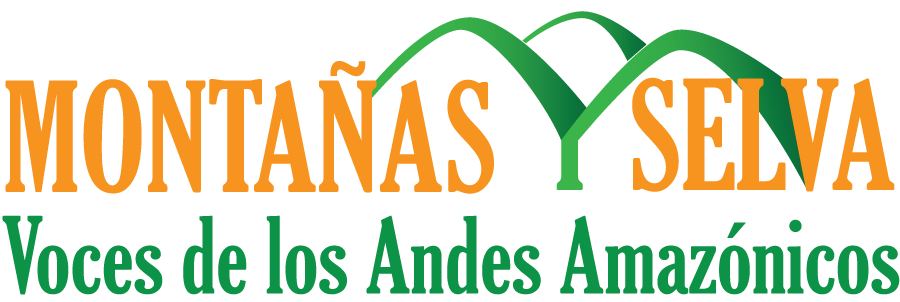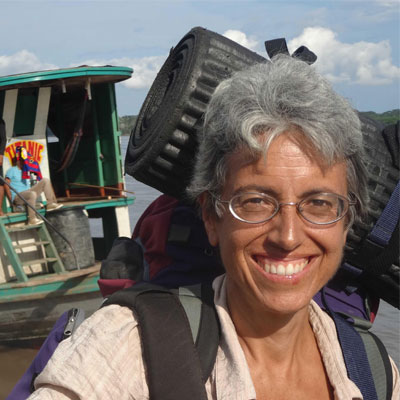
Barbara Fraser
Everyone talks about the “Amazon forest,” but when you’re there, you realize that it’s really a water world. The rivers are the roads for all kinds of vehicles — large riverboats carrying passenger…

Barbara Fraser
Everyone talks about the “Amazon forest,” but when you’re there, you realize that it’s really a water world. The rivers are the roads for all kinds of vehicles — large riverboats carrying passengers, cargo and even the occasional water buffalo; tugboats pushing barges stacked with timber or filled with oil; long-distance passenger boats with powerful motors; and small canoes weighed down with huge bunches of bananas or palm fruit.
River travel can be hazardous. Small boats can be swamped by the wake from powerful motors, and submerged logs are a danger even for large boats.
For all living beings in Amazonian Peru, life is regulated by the seasonal rise and fall of the water. Every year, the rivers overflow their banks, spreading nutrient-rich sediment through the forest and allowing fish to swim among the trees, eating their fruits and spreading the seeds.
High-water time is important for fishing, but it can be a time of scarcity in communities. The beaches where people grow beans and other crops disappear under as much as 20 or 30 feet of water. People rely on staples like cassava, planted on higher ground, but in places like Nueva Unión and Nuevo Perú, on Peru’s Chambira River, there’s no high ground nearby. So this can be a time of hunger.
We arrived in Nueva Unión to find the entire community flooded. Houses are raised on stilts, but the water had risen past the boards that would be the first floor in the dry season, so families had moved to the upper floor of their homes. The kitchens behind the houses, generally at a level half way between the two floors, were still above water. If you want to visit the neighbors, go to school or even go to the outhouse, you must paddle there in a canoe.
The same is true throughout the Amazon. People live surrounded by water. During the high-water season, a family bathes and washes clothes, pots and dishes on a small raft tied up at the door of their home beside their canoe. When the flood water recedes, those daily tasks — along with the raft and the canoe — move to the river bank.
Rivers and streams are also the only source of water for human consumption — something Peru’s standards for water quality do not take into account. In cities, most people turn on a tap for water, but in villages, the day starts with the ritual of fetching buckets of water from the river. That means people must often drink water that is polluted by waste from cities, villages and industrial sites upstream, including the oil fields. About 60 communities in the largest Amazonian oil blocks have temporary water treatment plants, but for everyone else, there is no choice. They must drink water that is known to be contaminated, in some places by toxics like metals and agricultural chemicals, and virtually everywhere by fecal coliforms.
In Peru’s Loreto region, where oil production has added billions of dollars to public coffers over half a century, only about half the residents are connected to public water systems, and even that water may not be adequately treated. There are no such systems in the hundreds of villages along the rivers. It’s a contradiction too long ignored by policy makers that in this world of delicate aquatic ecosystems, where water is life, water is also a public health hazard.
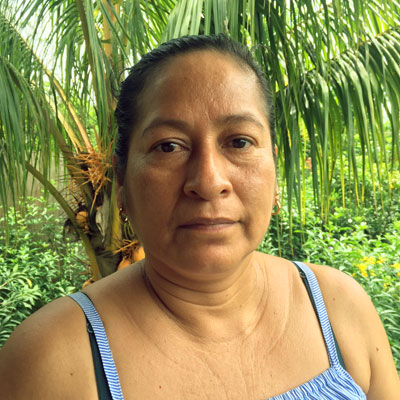
Marilez Tello
I was born on the banks of the Corrientes River, an area where the oil company is located, in a town called San Carlos, but I lived most of my childhood in Intuto, on the Tigre River…

Marilez Tello
I was born on the banks of the Corrientes River, an area where the oil company is located, in a town called San Carlos, but I lived most of my childhood in Intuto, on the Tigre River. Part of its lands are in Block 192, which at that time was called 1AB.
In the morning, before going to school, we children would go with the women to fetch water. We always saw black slicks, the whole river impregnated with oil, but nobody said anything because we didn’t know what it meant. We knew it was oil, but we didn’t know how much damage it could cause to our health.
It was common, especially after a heavy rain, to find large slicks of oil oozing over the river. The only way to draw water was to collect it from around the spilled oil with our containers, which generally were earthenware jars and the occasional aluminum pot or plastic bucket.
When I went to report from the Corrientes and Tigre rivers in 2018, I was 40 years old, and it was the first time I had been back to the area since I was 10. Something we had never addressed on the radio was the particular experience of women in the oil field. We had always listened more to the men, and they were always more inclined to talk about work. But women’s experience is different from that of men. We were able to gather the testimony of women who do not appear much in the reports on the oil issue.
The Kichwa and Achuar women’s memories of oil activity in the communities of the Tigre and Corrientes rivers are diverse. They include a helicopter landing in their community; being terrified of seeing strange people; hiding under a pile of clothes so as not to be seen; the salty water of the river and streams that could not be drunk and that remained on their bodies after bathing in the river; black smoke and soot falling on the roofs of houses when spilled oil was burned; large barges plying the river; layers of oil in the middle of the river and on its banks; large herons dressed in black; fish stranded on oil slicks; and animals such as deer and peccaries, which the men hunted to feed their families, soaked in oil.
For Lindaura Cariajano Chuje, a Kichwa woman from Vista Alegre on the Tigre River, remembering the first years of the presence of oil companies in her territory evoked the difficult times she went through and which she held in the depths of her heart. As we walked through an abandoned cemetery in the middle of the forest, she told us that many children and elderly people were buried there who died with severe stomach pains, vomiting and diarrhea after drinking water from the river.
The memories are painful: the suffering of women who lost a child or a family member and do not know what has happened. After keeping so much pain inside for so many years, I imagine that it is comforting to be heard. Lindaura is not the only one who lost children and family. Other communities have similar stories. These tragic events show the degree of emotional damage caused by an activity that does not respect people’s lives and livelihoods.
During the trip to Block 192, I remembered my mother, who lived much of her life in that area and never forgot. After my whole family left to live in more distant cities, where life was very different, the person who returned most often was my mother.
In 2019, we received word from the community of Vista Alegre that Lindaura had died of skin cancer — the same disease my mother died from seven years earlier. My family had also lived on the Corrientes and Tigre, two of the rivers most heavily polluted by oil activity, according to studies.
The testimonies we have gathered lead us to a clear message: The women and men of the Peruvian Amazon deserve and have the right to a healthy environment and a healthy life.
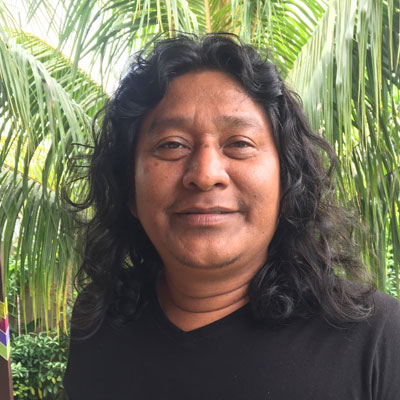
Leonardo Tello
One of Radio Ucamara’s main objectives is to work with indigenous groups in the Amazon region. The territory it covers is at the confluence of the Marañón and Ucayali rivers and is…

Leonardo Tello
One of Radio Ucamara’s main objectives is to work with indigenous groups in the Amazon region. The territory it covers is at the confluence of the Marañón and Ucayali rivers and is inhabited mainly by the Kukama people. The territory is vast and extends beyond the reach of our radio signal. In that territory there are also Urarina, Achuar and Quechua communities. I am the son of a Kukama father and Achuar mother and am director of Radio Ucamara.
For about 15 years, the radio station has had two programs in the Kukama language. In late 2021, we began broadcasting a program in the Urarina language, conducted by Jonatan Inuma Arahuata and Paquita López Rojas, a young couple from the communities of Nuevo Perú and Nueva Unión, on the lower Chambira River. Their program tells the stories of many people who, for the first time and in first person, recount the impact of the oil industry. Our next step is to visit the Chambira.
We are a delegation of seven people, including my 2-year-old son Tsaku. As soon as we enter the Chambira, we make our first stop in Ollanta. The naturally dark waters of the Chambira flood the entire area at this time of year, so it is only possible to travel by boat. Two hours later, we are in Nuevo Perú and 30 minutes after that in Nueva Unión, where we stay. From there we visit Nuevo Progreso, a community located near the mouth of the Tigrillo River, a tributary of the Chambira. We also visit areas where there have been oil spills. Everything is flooded, but the evidence of damage is harsh.
Tsaku’s eyes are restless — the river looks like a huge swimming pool, and he wants to try it. My heart aches. Our work in these territories is still insufficient. We are challenged and overwhelmed in every way by this reality, the reality of the Urarina people. The testimonies of men and women make this feeling even more acute. I take a deep breath and continue with the interviews.
We are immediately impressed in Nueva Unión by the way in which the Urarina have built up and fenced in a mound of soil so the flooding does not kill the cassava stems and plantain seedlings they have saved. They will plant them as soon as the river recedes. This farming technique is probably new because the Urarina are not normally accustomed to living in flood zones. They have been driven there by the need to get government assistance.
The oil concession known as Block 8 is in this territory. Stories of government neglect are repeated as in other watersheds, but here it is also visible in the bodies and faces of children and women. This strengthens our commitment to continue working side by side with them. We have been the first to enter the community as Radio Ucamara. This will open a path for others who want to help the Urarina people of the Chambira and make their demands heard.
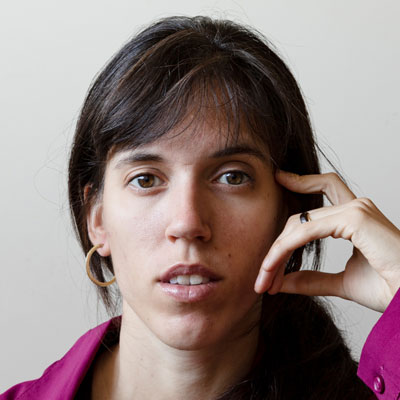
Ginebra Peña
The trip to the Urarina communities of the Chambira River represented a challenge for photography. Despite having photographed many people during these years in the Amazon…

Ginebra Peña
The trip to the Urarina communities of the Chambira River represented a challenge for photography. Despite having photographed many people during these years in the Amazon, nervousness was coursing through my body. I knew the Urarina had other ways of expressing themselves and I wondered if I would be able to read their consent to be photographed or their discomfort in their gestures, since we did not share the same language. (I usually rely on the body language of people when they see the camera to know if they want to be photographed or not. On very few occasions in my career have I considered it justifiable to impose the act of photography on an unwilling person, and this was certainly not going to be one of them).
Like any Westerner with a modicum of interest in being cordial with strangers, I am programmed to smile automatically. The encounter with the Urarina women was like looking into one of those carnival mirrors that distort the image into something comical. That’s how my own smile looked when I saw it reflected in their seriousness.
I was left disarmed and without my first tool for breaking the ice. I quickly understood that among the Urarina, there are no social smiles; laughing is a spontaneous expression and my permanent smile must have seemed silly. What an idiot they must have thought I was. After being with me for a while, I imagine they must have understood that it was not an acute case of idiocy, but rather an effort at courtesy on my part. They tried to return it in a gesture that made me feel even more ridiculous, but well received. That made my job easier.
Another difficulty in doing my work, besides not sharing the social conventions of the gesture, was that the communities were flooded. I did not have a canoe at my disposal to move around freely, which hindered another of my fundamental tools for portraying everyday life: wandering around the community and chatting from house to house.
Communication with women in the neighboring houses, since I was unable to overcome the distance that separated us, was based on glances during the three days we were there. With one young woman in particular, who must have been a few years younger than me and lived in the house next door, we observed each other with a kind of complicity. I never set foot in that house — as much as I would have liked to.
This reminded me of “Rear Window,” but the Urarina people’s houses do not have walls, for the most part, so I photographed her openly from a distance and she welcomed my photography, enjoying the game and showing me her daily activities. I thought it was just my imagination, but the day we left she gave me a huge smile and a very affectionate wave that made me think of a warm reciprocity. We did not exchange words, but in a way we observed and understood each other.
Time and work went by, and I continued to observe with fascination the (non) gestures of the women and teenagers I photographed. The expressiveness on their faces was restrained and measured at almost all times. It seemed that only grandmothers had the power to break this unspoken rule. Seriousness seems to be the social consensus among adults, I thought. However, that changed when we went to the community of Nuevo Perú, to the house of the family of Paquita López Rojas, a young Urarina woman from the Radio Ucamara team, who with her partner, Jonatan Inuma Arahuata, is hosting the station’s first program in the Urarina language.
Radio Ucamara Director Leonardo Tello launched a drone to make aerial images of the communities. As soon as the drone took flight, the family’s composure gave way to an expression of true surprise, along with a spontaneous burst of curiosity, fear and joy. I wondered wistfully when was the last time something had astonished me like that. How do you think when you were born in the bosom of a community? What is it like to be and feel part of the community and the surroundings?
